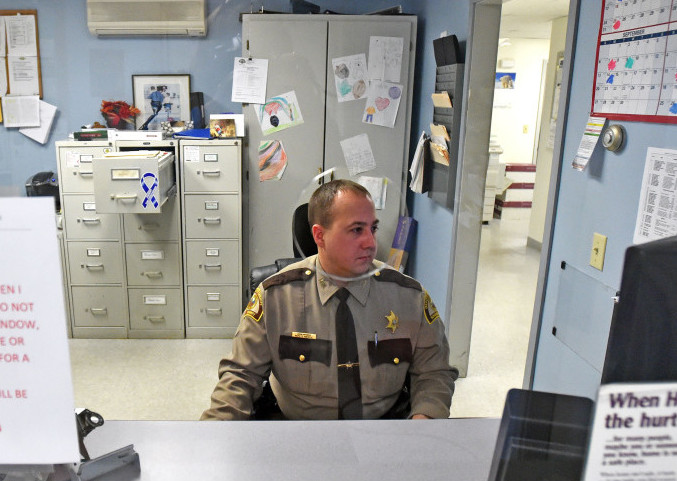MADISON — The number of crimes solved by police in Madison has increased by more than 40 percent over the same period last year in the first five months since the Madison Police Department consolidated with the Somerset County Sheriff’s Office, according to monthly reports the sheriff’s office filed with town officials.
On average, about 81 percent of reported crimes have been solved each month since July, according to the office’s November monthly report, the most recent report generated.
In comparison, the former Madison Police Department averaged about 40 percent of crimes being solved in the same period last year.
Nearly six months later, Somerset County Sheriff Dale Lancaster, who has overseen the Somerset County Sheriff’s Office Madison Division since its inception, attributes the increase in resolved cases to changes in staffing structure and policing philosophy.
Specifically, the sheriff’s office has appointed one of the division’s five deputies to work only on case follow-up, and Lancaster said he has tried to enforce a “policing with purpose” philosophy that encourages deputies to get to know the community not just when a call comes in, but by walking the downtown and visiting with the local schools and businesses.
“We’re focusing the work effort and we’ve established new expectations,” Lancaster said. “We want to be more sensitive to the community needs.”
Meanwhile, the number of crimes against people — cases such as assaults and robberies — has stayed about the same in 2015, while the number of property crimes — such as arson, motor vehicle thefts and fraud — are up 25 percent so far, according to the sheriff’s office.
The increase in solved criminal cases follows a decision by Madison residents in June to consolidate the former Madison Police Department with the Somerset County Sheriff’s Office, a move that town officials said would save about $130,000 annually, largely through the elimination of the police chief position, formerly held by Barry Moores. The change followed months of debate over the pros and cons of consolidating with the sheriff’s office, a proposal that was driven largely by the need to reduce municipal spending in the wake of a $150 million drop in tax value at Madison Paper Industries. It went into effect in July.
The department has had a large turnover in officers since the transition, with three officers and a former administrative assistant leaving Madison over the last six months. Cpl. Joe Mitchell retired; Officer Brett Lowell transfered to the Augusta Police Department; and a third officer, Sgt. David Trask, did not make it through a probationary period during the transition.
Keeping officers at the department was always a challenge for the Madison Police Department because of its small size, according to Chairman of the Board of Selectmen Al Veneziano, who said he was not surprised by the turnover that came with the department consolidation.
“Change of officers has always been an issue for us,” he said. “They’re always going to want to go to bigger departments that have more resources and more ability for promotion.”
The administrative assistant, Stacey Slate, was transfered to a different position within the sheriff’s office. Lancaster said he could not go into detail about the reasons why Trask did not complete the transition to the sheriff’s office.
Getting the department fully staffed is one of Lancaster’s priorities as the transition continues. The role of the deputy assigned to follow-up on cases is not filled, but as soon as the division has five full-time deputies, it will be, he said.
“It allows for a more proactive and comprehensive follow-up on investigations,” Lancaster said. He said he hopes the division, which is supervised by Sgt. Mike Knight, who is in Madison two to three days per week, will be back at full capacity by February.
In addition to the emphasis on follow-up on cases, Lancaster said he has shared his “policing with purpose” philosophy with the Madison division of the sheriff’s office, which he described as a combination of community-based and intelligence-based policing.
“The two have to be side-by-side to be successful,” Lancaster said. “That means you not only have to look at your statistics on where your crime is in a community, but you also have to look at what the community perceives to be issues and help to be problem-solvers within the community. The days of the officer just getting in a car and driving around have evolved.”
Lancaster said he asks officers in the summer to meet with camp owners, to walk the downtown area when they’re not busy and to interact more with the Madison schools and get to know school administrators.
“That’s how we’ve evolved,” he said. “We’re only six months into this, so they’re still getting used to me; but for the most part, the officers have been very receptive to the changes and wanting to move forward.”
The rise in clearance rates — which represents the percentage of open criminal cases that get solved each month — can also be attributed to the officers and their willingness to work with the sheriff’s office on the transition, Lancaster said.
Eric Bronson and Craig Dyer, both of whom are still with the division, completed a training program with the sheriff’s office that included ride-alongs with deputies, working with more experienced officers and studying the office’s policies and procedures, which they were also tested on, Lancaster said.
At a public hearing in April, residents voiced concerns about potential changes in 24-hour coverage, fears that deputies would be called to other parts of the county and away from calls in Madison and the logistics of transferring the department’s employees and equipment to the sheriff’s office.
Lancaster and town officials say few of those concerns have materialized in the months since the transition.
“Everyone is always concerned with change,” Veneziano said, “but I think there’s been a police presence and I think people have been happy with that. I even see more and more sheriff’s trucks in town, so to my knowledge, it’s worked very well so far.”
Town Manager Tim Curtis also said that the town has seen a cost savings from the consolidation and has not yet had to draw money from a $2.5 million line of credit established in September to offset the tax shortfall from Madison Paper Industries.
Madison deputies were called out of town just once in October, to deal with a burglary in Anson; twice in September, for other incidents in Anson; and twice in November, once for a follow-up in Norridgewock and once for a fatal car accident involving a Madison man in Starks. Deputies were not called out of Madison in July or August.
Those calls did not differ from what would have been expected in a mutual-aid situation between the sheriff’s office and small independent police departments, Lancaster noted.
Town officials said communication with Lancaster and others members of the division has gone smoothly since the transition, with the Board of Selectmen and the town manager both receiving regular updates from him. The printed monthly reports, which are available at the Town Office for the public to look at, are also new.
Initially the town entered into a one-year contract with the sheriff’s office that will be up for renewal in June. Veneziano said the Board of Selectmen will begin looking at renewing the contract after Jan. 1, but he sees no reason why it would not be renewed.
“It makes sense for us,” he said. “There’s more follow-up, more looking deeper into things than we had the ability to do.”
Rachel Ohm — 612-2368
Twitter: @rachel_ohm
Send questions/comments to the editors.





Success. Please wait for the page to reload. If the page does not reload within 5 seconds, please refresh the page.
Enter your email and password to access comments.
Hi, to comment on stories you must . This profile is in addition to your subscription and website login.
Already have a commenting profile? .
Invalid username/password.
Please check your email to confirm and complete your registration.
Only subscribers are eligible to post comments. Please subscribe or login first for digital access. Here’s why.
Use the form below to reset your password. When you've submitted your account email, we will send an email with a reset code.